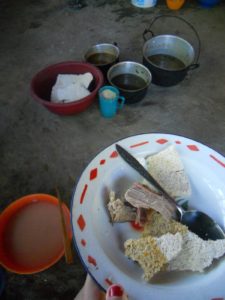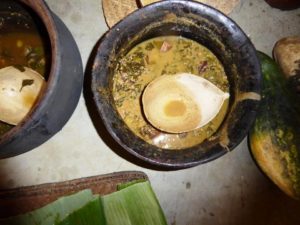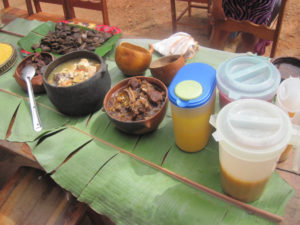As we celebrate Indigenous Heritage Month, the ‘tuma pot’ will be a popular offer on many menus. Tuma pot is commonly known as a meal, but did you know it is also an actual pot (container)?
In an interview with Sunday Times Magazine, Lokono Arawak archaeologist, George Simon, explained how the pot is made and the cuisines enjoyed from it.



Tuma pots are principally associated with the Rupununi savannah peoples, the Macushi in the north and Wapishana in the south. No doubt the tradition of pottery making once existed among coastal indigenous nations, but today it is difficult to find potters who still make ceramic pots. Sadly, the skill seems to have been lost.
In the south savannahs, however, among the Wapishana, the tradition is still very much alive, though not every Wapishana village produces them. The Wapishana village of Waranau still produces these particular pots. The Wai Wai also produces tuma pots. Villagers in the south savannahs would therefore access their pots from particular potters from other villages. Toka village in the north once boasted of a strong pottery making tradition, but the skill has been lost with the passing of their skilled potters. The younger generation of Machusi in that village has not upheld the pottery tradition.
The tuma pot is made from clay and is fired at low temperature in an ‘open fire’ system of pottery making. The potter would have collected the clay from a particular clay source, not found in most villages. The clay is processed and refined and sometimes ash, crushed pottery fragments, and fine sand are included in the clay to strengthen it. Once the base of the pot is established, the body of the pot would be made, and from coils of clay, gradually building and fashioning the shape outwards towards the shoulder and then inwards to form the neck, which will then be developed outward to form the rim.
The base of the pot can be flat or oval. The oval pots are placed on the ground in a shallow hole and supported by three rocks. The flat based pots can rest on the ground or be placed on three rocks over the fire wood.
Tuma refers to something that is tasty, mouth-watering, hence tuma pot – “food that is delicious”. Another Wapishana word is “damuriid”, which refers to tuma pot or pepperpot.
Most importantly, the tuma pot brings people together in villages. The making of the pot is a collaborative effort and the meal made in the pot is enjoyed as a group.
Indigenous cuisines
In prehistoric times, the indigenous people roamed about freely in the forests and savannahs as expert hunters, fishermen and tropical forest collectors.
Today, in Guyana, the nine indigenous nations live in different parts of the country, some in the rich alluvial swamp lands of the coastal plain, and others in the terra firm of the hinterland. These two environments bid fair for providing the inhabitants with adequate food resources, which are used in a sustainable manner.
The Arawaks, Caribs and Warraus live on the north/west and east coast swampy region of the country, the Arecuna, Akawaio and Wai Wai in the forested and riverain region, the Patamona on the part forest/ part savannah Pakaraima Mountains, and the Macushi and Wapishana on the flat Rupununi savannahs. Each nation is a master of his environment.
In the wild coast of Guyana, the north/west region of the country has some 30 shell mounds. These mounds attest to the magnitude of subsistence resources available to the first inhabitants in the region, such as the Carib, Warrau and Arawak, who still live there.
Archaeologists have excavated some of these mounds and marvelled at the remains found in them, as they revealed that the inhabitants consumed a variety of animals, birds and seafood, which included a variety of fish, shellfish, crab, oyster, lobster, shrimp, and snails. Vegetables, fruits and nuts gathered from the forest and reefs supplemented their diet.
The Upper Mazaruni is home to the Arecuna and Akawaio, the Pakaraima Mountains to the Patamona, and the Upper Essequibo to the Wai Wai. These four nations live in almost the same environmental situation and get their supply of food from the rivers and forest where there is an abundance of animals, fish and birds. The most popular game animals are the deer, wild cow, wild hogs, labba, acuri (agouti), sloth, manatee, capybara, alligator and all types of monkeys. They also hunt birds like the powis, marudi, maam, and pigeons. Frogs, maggots and insects, both land and river turtles and turtle eggs, vegetables and fruits are collected from the forest, and a variety of fishes and eels from rivers are all part of their diet.
For the Macushi people, who live in the north, and the Wapishana, to the south Rupununi savannah, their food supply originates from the savannahs, the Rupununi River and streams that drain the vast savannah. The Rupununi savannah and the Pakaraima Mountain region have an abundance of ants, armadillo, swamp birds, and savannah deer that add to their diet.
The tuma pot is used to cook all these succulent meats, which is served with delicious cassava bread. (Information by George Simon)



